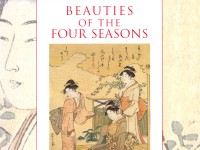Beauties of the Four Seasons
A full catalogue of the Ashmolean’s collection of Japanese bijinga (beautiful women) prints by Mitsuko Watanabe (published Oxford, 2005).

Publications online: 54 objects
Woman and child holding a kimono
-
Literature notes
The precise dates of Isoda Koryūsai are unknown but he was active as an artist from the end of the Hōreki (1751-64) to the beginning of the Kansei (1789-1801) periods. Koryūsai worked in the style of Suzuki Harunobu, using the name Suzuki Haruhiro, until Harunobu’s death in 1770. Koryūsai then created his own style and became one of the most popular artists for prints of beauties during the Anei period (1772-81), helping to establish the ōban size [see EAX.3954] print. He also excelled particularly in the hashira-e (pillar print), which was designed for hanging on interior pillars of Japanese houses. He later received the honorific title, 'Hokkyō', in recognition of his contribution to the art world.
The use of pale colours and the depiction of the lady and child is reminiscent of the Harunobu style. The woman is holding a new kimono, as if showing it to an invisible viewer, helped by the child; one of the sanseki no uta (the three poems on autumn evenings) by the Monk Jakuren (Fujiwara no Sadanaga) is inscribed on the sleeve.
The colours have faded and the colour of the sleeve was probably originally a greyish-purple. -
Details
- Series
- Fashionable Sleeves for the Three Evening Poems
- Associated place
- Date
- 1764 - 1770
- Artist/maker
-
Isoda Koryūsai (1735 - 1790) (designer)Jakuren hōshi (1139 - 1202) (author)
- Material and technique
- woodblock, printed with water-based vegetable pigments
- Dimensions
-
mount 40.5 x 27.8 cm (height x width)
sheet 26 x 19.5 cm (height x width)
print 25.3 x 18.8 cm (height x width)
- Material index
- Technique index
- Object type index
- No. of items
- 1
- Credit line
- Presented by Mrs Allan and Mr and Mrs H. N. Spalding, 1952.
- Accession no.
- EAX.4044
-
Further reading
Oxford: Ashmolean Museum, 24 August-30 November 2005, Beauties of the Four Seasons, Mitsuko Watanabe, ed. (Oxford: Ashmolean Museum, 2005), no. 3 on p. 6, illus. p. 7
Glossary (2)
kimono, vegetable pigments
-
kimono
Kimonos, or 'the thing worn' in Japanese, had seasonal designs. The style of kimonos would change four times a year, and winter kimonos would be padded.
-
vegetable pigments
Vegetable pigments were used to create coloured dyes for Japanese prints, paintings, and textiles. These pigments often faded over time due to the chemical reactions they underwent.
Location
-
- currently in research collection
Objects are sometimes moved to a different location. Our object location data is usually updated on a monthly basis. Contact the Jameel Study Centre if you are planning to visit the museum to see a particular object on display, or would like to arrange an appointment to see an object in our reserve collections.
Publications online
-

Beauties of the Four Seasons
The precise dates of Isoda Koryūsai are unknown but he was active as an artist from the end of the Hōreki (1751-64) to the beginning of the Kansei (1789-1801) periods. Koryūsai worked in the style of Suzuki Harunobu, using the name Suzuki Haruhiro, until Harunobu’s death in 1770. Koryūsai then created his own style and became one of the most popular artists for prints of beauties during the Anei period (1772-81), helping to establish the ōban size [see EAX.3954] print. He also excelled particularly in the hashira-e (pillar print), which was designed for hanging on interior pillars of Japanese houses. He later received the honorific title, 'Hokkyō', in recognition of his contribution to the art world.
The use of pale colours and the depiction of the lady and child is reminiscent of the Harunobu style. The woman is holding a new kimono, as if showing it to an invisible viewer, helped by the child; one of the sanseki no uta (the three poems on autumn evenings) by the Monk Jakuren (Fujiwara no Sadanaga) is inscribed on the sleeve.
The colours have faded and the colour of the sleeve was probably originally a greyish-purple.
Notice
Object information may not accurately reflect the actual contents of the original publication, since our online objects contain current information held in our collections database. Click on 'buy this publication' to purchase printed versions of our online publications, where available, or contact the Jameel Study Centre to arrange access to books on our collections that are now out of print.
© 2013 University of Oxford - Ashmolean Museum

